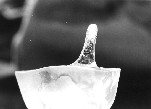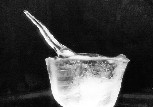为何冻冰块时会长出尖刺?


为什么冰会长出尖刺呢?
一句话解释:冰在急冻时处于过冷状态,冰的表面会出现小孔洞,这样冻结时水会膨胀。 随着冰冻的继续,冰面内不断膨胀的冰迫使剩余的水通过孔,并在边缘周围冰冻,形成钉状。 最终,整块冰冻结后也就形成了尖刺。
具体来说:冰块晶体的形式与冷却速率有关,也就是过冷程度。过冷程度高有利于冰晶迅速覆盖表面,有些冰晶垂直进入水中。 这些冰晶倾向于以夹角60度结合,并在表面上留下三角形孔。 因此,尖刺结构的底面往往是三角形。 尖峰的侧面有时是先前存在的微晶的延续,并且能够以陡峭的角度从表面延伸。
图片
在非常冷(-10到-20摄氏度)的快速冰冻条件下,较容易形成尖刺。而在无霜冷冻室中,最初形成的尖刺会由于升华现象而最终变成弧形。
- My Flickr set of ice spike photos and videos (where you can leave comments).
- Ice spike from my freezer in Santa Barbara. Photo by Mary de Bruyn.
- Inclined ice spike. Photo by Miles Chen, Berkeley CA.
- Tapered spike. Photo by Miles Chen.
- Spike in color. Photo by Miles Chen.
- Small spike showing interior crystals. Photo by Miles Chen.
- Spike on an ice cube. Photo by Andy Haley.
- Horn on an ice cube. Photo by Jay Allen.
视频
- A quicktime movie of a spike growing, made by Michael T. Rosenstein. Note the clock showing the speed of the process. You can just see the final bit of water freezing in the interior of the spike.
- Compressed avi movie of a controlled ice spike growth experiment. The frame rate is about 50X normal time. The air temperature was -11.5C and the grid squares are 1 mm. The colours that appear on the ice surface toward the end of the video are potassium permanganate crystals sprinkled onto the ice. It looks as if there is evidence of a liquid layer on the surface, suggesting (though not conclusively) that there is some overflow at the spike orifice near the end of its growth. Movie made in the ice lab of Edward Lozowski at the University of Alberta. Movie by Lesley Hill, Russ Sampson and Edward Lozowski, with technical help by Kenny Lozowski.
- Two videos of a freezer experiment to grow spikes: [video 1][video 2] provided by Christian Krause. Full credits: Grundpraktikum Physik, Heinrich Heine Universität Düsseldorf Vadim Abramov, Christian Keller, Christian Krause, Masdak Nadem Boueni, Serkan Özdemir, Kapilan Paramasivam.
室外
在自然环境中偶尔会看到尖刺。 由于形成尖刺需要在过冷条件下快速冷冻,因此通常是有人将室温水留在户外过夜而形成的。
- An image of a spectacular spike seen in Anne Davies’ backyard birdbath in Comox British Columbia, January 11, 2003. The grey object is a rock which holds the tub on top of a post. Photo by Marilyn McCourt.
- A side view of the birdbath spike.
- A closer view of the birdbath spike.
- A spike in the birdbath belonging to Edward and Rosemary Williams, in Malvern, Worcs, UK. Night temperature was -6C.
- Closer view of Malvern spike.
- Ice Vases that appeared in Sarah Longrigg’s backyard in Scotland.
- An account of a 1963 walk across frozen Lake Erie, during which natural ice spikes “the size of telephone poles” were observed. By Harold Kirk, from the Harbor Creek Historical Society Newsletter. Thanks to Beth Simmons.
- Four images [1][2][3][4] of icespikes taken on January 2, 2010, about 15 miles east of Richmond, Virginia USA, by Anne Morrow Donley. The first two are of the dog/cat water bowl; the other two are “down near the chicken yard in buckets that catch the runoff of rainwater from the chicken house”.
- Ice spikes on a frozen stream downstream from a weir, Des Lacs River near Foxholm, North Dakota, Winter 2010-2011.
- Seven images of an amazing ice spike in the form of an inverted pyramid: [1] [2] [3] [4] [5] [6] [7], taken by Steven Hilsdon, Roy, Washington, USA. The temperature was -1.7C. You can clearly see the crystals in the surface of the rest of the ice.
相关链接
- “Ask the Experts” column piece in Scientific American. Appeared on page 102, of the July, 2007 issue.
- The explanation of “stalagmite ice”, according to New Scientist’s Last Word column for 15 April, 2006.
- A description of the process as observed by Miles Chen.
- An undergraduate research report on the phenomenon by Miles Chen (1993). [2.7MB, pdf format].
- Another page about ice spikes by Kip Trout.
- SnowCrystals.com — an excellent page about spikes.
- A detailed laboratory study of ice spikes by K. Libbrecht and K. Lui (2003). [pdf].
- How to make your own ice spikes, with a gallery of images, from New Scientist magazine.
参考文献
- H. E. Dorsey, “Peculiar Ice Formation”, The Physical Review (series I), vol. 18, p. 162 (1921). [available here from PROLA] Describes and shows images of a spike observed on the night of December 15, 1916.
- D. C. Blanchard, Journal of Meteorology, vol. 8, p. 268 (1951). Describes spicules on sleet pellets.
- B. J. Mason and J. Maybank, Quarterly Journal of the Royal Meteorological Society, vol. 86, p. 176 (1960). Describes spicules on and splintering of sleet pellets.
- J. Hallet, Journal of Glaciology, vol. 3, p. 698 (1960). Describes the crystalography of the spikes in detail.
- Thomas Wäscher, “Generation of slanted gas-filled icicles,” Journal of Crystal Growth, vol. 110, p. 942-946 (1991).
- Helene F. Perry, The Physics Teacher, vol. 31, p. 112 (1993), and followup letters in vol. 31, p. 264 (1993). The “last word on ice spikes”, The Physics Teacher, vol. 33, p. 148 (1995).
- G. Abrusci, American Journal of Physics, vol. 65, p. 941 (1997). Describes an outdoor spike sighted in January 1997.
- C. A. Knight, American Journal of Physics, vol. 66, p. 1041 (1998). Response to the previous reference.